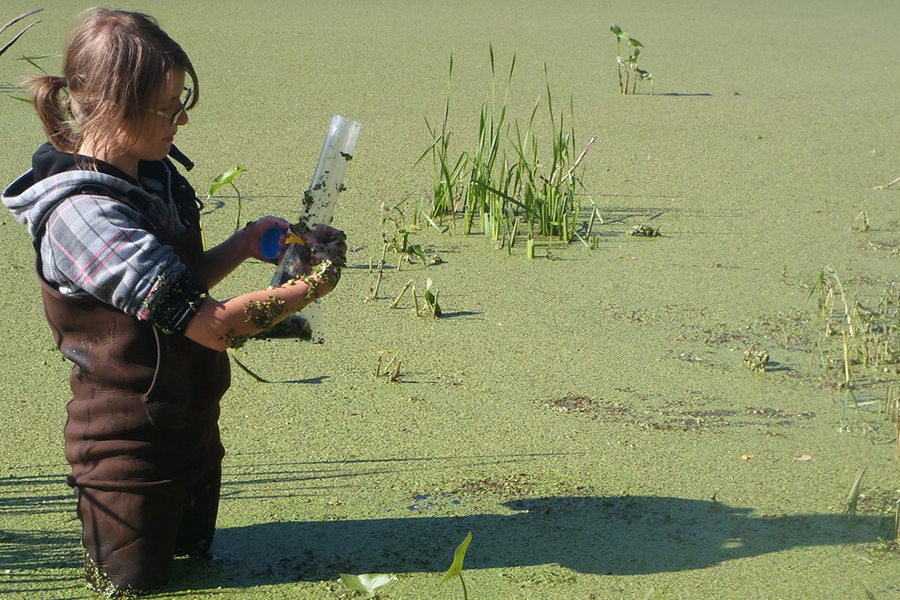
Wild wild water
In the wild, nothing seems to frighten Raea Gooding. She once ran for her life from an angry elephant in Nepal, and she has been metres away from polar bears on the tundra.
By Federica Giannelli
"None of these things scare me as much as the degradation of our water sources right here, right now," said Gooding, who recently completed a master's project at the University of Saskatchewan on improving the water quality of Lake Winnipeg, Man.
Her family has a cabin on Lake Winnipeg, which in 2013 was named the world's most threatened lake by Global Nature Fund.
"I have seen the degradation of Lake Winnipeg firsthand, and it is very rewarding to help find potential solutions," Gooding said.
Algal blooms are a major concern for water quality in rivers and lakes, as well as for their potential toxicity to people and animals. Last summer, media reported that Lake Winnipeg experienced severe blooms, making it dangerous for people to swim and for animals to drink the water.
The slimy, plant-like organisms receive a growth boost when nutrients such as nitrogen in fertilizers make their way into bodies of water.
"We need to find ways to feed our communities without polluting our most important resource—water," Gooding said.
She found that when farmers build small dams in their fields, the bacteria in the reservoirs remove nitrogen, a process called denitrification, and help reduce its accumulation in the water. This means that dams have potential to ease the problem of algal blooms in the future.
Denitrification is known to be important in larger reservoirs such as Lake Diefenbaker, but this is the first time it has been studied in small dams, said Helen Baulch, professor at the U of S Global Institute for Water Security and Gooding's supervisor.
"Millions of dollars are invested annually on beneficial water management practices, so we need this type of research to ensure those dollars are being invested wisely," Baulch said.
Gooding's research goal was to better understand the conditions needed to maximize nitrogen elimination in the dams.
After measuring the level of bacterial processing and chemical elements in water and sediments, she found that the bacteria removed more nitrogen when the quantity of oxygen was low and carbon was high.
This information can now be used to help design better dams by adjusting the dimensions or other features of the dams to create the best chemical conditions for removing nitrogen and other nutrients, Gooding said.
She worked closely with landowners in the Lake Winnipeg area, who were very committed to helping build and manage the network of 50 dams. They keep monitoring their effectiveness even now that the project has concluded.
The federal research funding agency NSERC, in partnership with the Canadian Water Network, oil company Nexen and Nature Saskatchewan provided funding for Gooding's research.
Article written by Federica Giannelli, a graduate student intern in the U of S research profile and impact unit. This article first ran as part of the 2015 Young Innovators series, an initiative of the U of S Research Profile office in partnership with the Saskatoon StarPhoenix.
Her family has a cabin on Lake Winnipeg, which in 2013 was named the world's most threatened lake by Global Nature Fund.
"I have seen the degradation of Lake Winnipeg firsthand, and it is very rewarding to help find potential solutions," Gooding said.
Algal blooms are a major concern for water quality in rivers and lakes, as well as for their potential toxicity to people and animals. Last summer, media reported that Lake Winnipeg experienced severe blooms, making it dangerous for people to swim and for animals to drink the water.
The slimy, plant-like organisms receive a growth boost when nutrients such as nitrogen in fertilizers make their way into bodies of water.
"We need to find ways to feed our communities without polluting our most important resource—water," Gooding said.
She found that when farmers build small dams in their fields, the bacteria in the reservoirs remove nitrogen, a process called denitrification, and help reduce its accumulation in the water. This means that dams have potential to ease the problem of algal blooms in the future.
Denitrification is known to be important in larger reservoirs such as Lake Diefenbaker, but this is the first time it has been studied in small dams, said Helen Baulch, professor at the U of S Global Institute for Water Security and Gooding's supervisor.
"Millions of dollars are invested annually on beneficial water management practices, so we need this type of research to ensure those dollars are being invested wisely," Baulch said.
Gooding's research goal was to better understand the conditions needed to maximize nitrogen elimination in the dams.
After measuring the level of bacterial processing and chemical elements in water and sediments, she found that the bacteria removed more nitrogen when the quantity of oxygen was low and carbon was high.
This information can now be used to help design better dams by adjusting the dimensions or other features of the dams to create the best chemical conditions for removing nitrogen and other nutrients, Gooding said.
She worked closely with landowners in the Lake Winnipeg area, who were very committed to helping build and manage the network of 50 dams. They keep monitoring their effectiveness even now that the project has concluded.
The federal research funding agency NSERC, in partnership with the Canadian Water Network, oil company Nexen and Nature Saskatchewan provided funding for Gooding's research.
Article written by Federica Giannelli, a graduate student intern in the U of S research profile and impact unit. This article first ran as part of the 2015 Young Innovators series, an initiative of the U of S Research Profile office in partnership with the Saskatoon StarPhoenix.

